
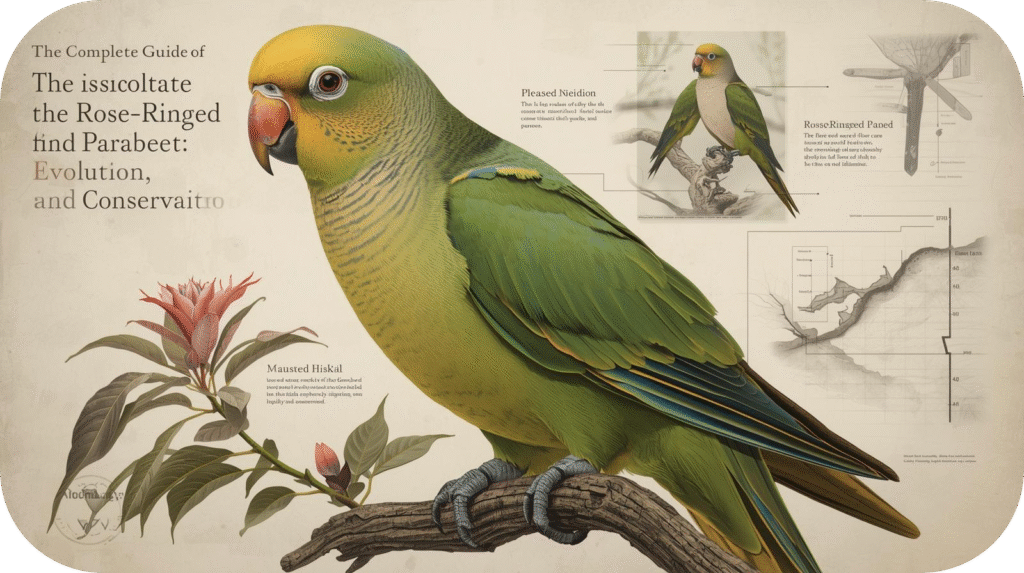
Introduction: Meet the Rose-Ringed Parakeet Lifespan
The rose-ringed parakeet, also called the ring-necked parakeet, is a charming bird. It has captured the hearts of pet lovers and birdwatchers around the world.
With its vibrant green plumage, striking red beak, and impressive long tailed silhouette, this bird is a true natural spectacle. Its amazing intelligence and ability to mimic human speech make it a fascinating pet. However, owning one is a big commitment that can last 30 years or more.
This article is your complete guide to caring for rose-ringed parakeet lifespan. It covers housing, diet, and their complex behaviors. We will also look into the amazing science of their flight and tail feathers. We will explore their long evolutionary history that links them to dinosaurs.
Finally, we will look at their status as global citizens. We will explore their role as native birds in some areas. We will also discuss their impact as an invasive species in other places. Lastly, we will see how we address these issues.
Comprehensive Care for Your Rose-Ringed Parakeet Lifespan
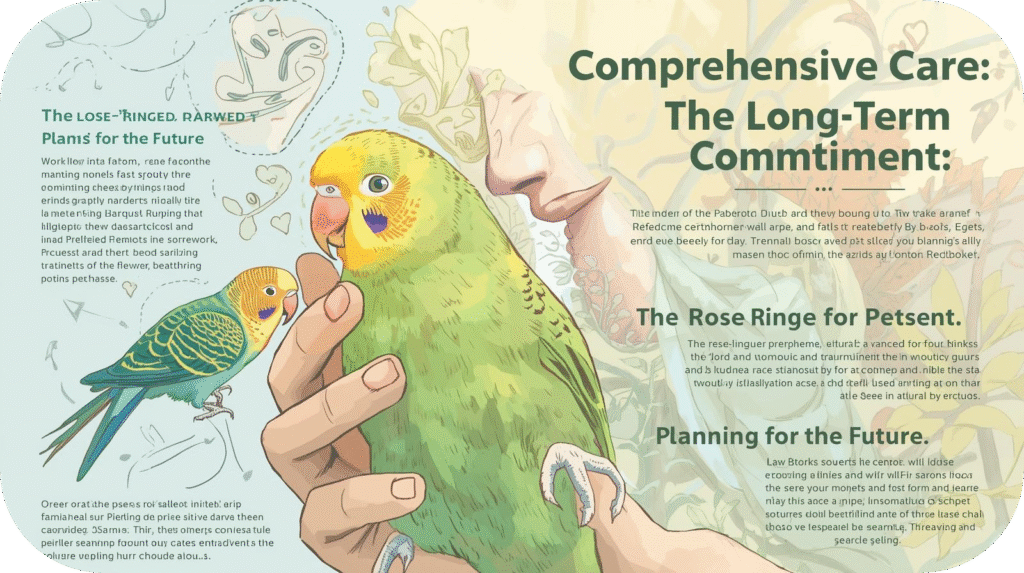
The Long-Term Commitment: Planning for the Future
Welcoming a rose-ringed parakeet lifespan into your home is a decision that should not be taken lightly. People know these parrots for their exceptional longevity, with a typical lifespan of 25 to 30 years in captivity. This means that adopting one is a lifelong partnership that requires dedicated planning for their future care.
Potential owners should think about life changes. These include job changes, growing families, and plans for their bird in their will. This 30-year commitment requires time and love. It also needs ongoing financial support for good food, vet visits, and proper housing.
Understanding Their Personality and Behavior
The ring-necked parakeet is a bird of contrasts—both charming and challenging. They are highly intelligent and social creatures, capable of learning a vast vocabulary and mimicking sounds with astonishing clarity.
However, this intelligence requires constant mental stimulation. Without enough toys, training, and social interaction, they may develop problems. These can include screaming, feather plucking, or aggression.
Unlike some friendly parrot species, rose-ringed parakeets lifespan like to interact on their own terms. They may form a strong bond with just one person. Providing exceptional care means understanding and respecting their independent nature while ensuring they feel like part of the family.
Creating the Perfect Habitat: Housing and Enrichment
For these active and energetic birds, a spacious cage is non-negotiable. The minimum size for a single rose-ringed parakeet is 36 inches long, 24 inches wide, and 24 inches tall. However, a larger space is always better. A flight-style cage is ideal, allowing room for crucial wing stretches and short flights.
The cage interior should be a stimulating environment. Essential components include:
- Multiple Perches: Offer a variety of diameters, textures, and materials (natural wood, rope, cement) to promote foot health.
- Engaging Toys: Offer a variety of puzzle toys, shreddable items, and foraging devices. These will challenge their minds and keep them from getting bored.
- Separate Food Stations: Use different bowls for pellets, fresh foods, and treats. This helps you track what your pet eats and promotes a balanced diet.
Their long-tailed body needs a cage that lets them move freely. This helps protect their beautiful tail feathers.
Diet and Nutrition: The Foundation of Health

A balanced diet is the cornerstone of exceptional care and ensures your ring-necked parakeet lives a long, healthy life. In the wild, their diet is highly varied, and captive birds need similar diversity.
- High-Quality Pellets: Should form about 60-70% of their daily diet, providing a balanced base of essential nutrients.
- Fresh Vegetables: Offer daily, focusing on dark leafy greens (kale, spinach), broccoli, bell peppers, and carrots.
- You can give fruits in moderation (10-15% of the diet) due to their high sugar content. Apples, pears, and berries are excellent choices.
- Consider seeds and nuts as high-fat treats, and limit them to no more than 5-10% of the total diet to prevent obesity.
Always avoid toxic foods like avocado, chocolate, caffeine, and alcohol. Fresh, clean water must be available at all times.
Table: Foods to Avoid for Rose-Ringed Parakeets Lifespan
| Food Category | Specific Examples | Potential Risks |
|---|---|---|
| Toxic Foods | Avocado, chocolate, caffeine, alcohol | Cardiac and neurological toxicity, potential death |
| High-Salt Foods | Processed snacks, salted nuts, chips | Kidney damage, excessive thirst, dehydration |
| High-Fat Foods | Fried foods, excessive seeds, fatty meats | Obesity, fatty liver disease, heart problems |
| Fruit Pits & Seeds | Apple seeds, cherry pits, apricot pits | Cyanide poisoning |
| Onion & Garlic | Raw, cooked, or powdered forms | Digestive irritation, anemia |
| Mushrooms | All types of mushrooms | Digestive upset, potential liver failure |
| Dairy Products | Milk, cheese (in large amounts) | Digestive issues, as birds are lactose-intolerant |
The Science of Feathers: Nature’s Masterpiece

The Anatomy of a Feather: More Than Meets the Eye
Bird feathers are among the most complex integumentary structures found in vertebrates . Each feather is a marvel of biological engineering. The central shaft, called the rachis, is the backbone of the feather. From the rachis extend hundreds of branches called barbs, and from each barb come even smaller branches called barbules.
These barbules have tiny hooks called barbicels. They connect like Velcro. This creates a smooth surface that is important for flight. When a bird preens, it is often re-fastening these tiny hooks to repair its feathers.
Flight Feathers: The Engines of the Sky
Flight feathers are the long, stiff, asymmetrical feathers on the wings and tail that are critical for flight . They are divided into two main types:
- Remiges: The Wing Feathers: These are the wing feathers attached to the posterior side of the wing. They are themselves divided into primaries and secondaries. The “hand” bones attach to the primaries, which serve as the principal source of thrust, propelling the bird forward. The secondaries, attached to the ulna (forearm), are crucial for generating lift .
- Rectrices: The Tail Feathers: These are the stiff tail feathers that help the bird with braking, steering, and stability during flight . Most bird species, including the rose-ringed parakeet lifespan, have six pairs of rectrices.
The front edge of the wing is made up of smaller alula feathers. These feathers work like slats on an airplane wing. They help prevent stalls when flying at low speeds.
Table: Types and Functions of Key Feathers in Rose-Ringed Parakeet Lifespan
| Feather Type | Location | Primary Function |
|---|---|---|
| Primaries | Outer wing (attached to manus) | Generate thrust and help with forward movement |
| Secondaries | Inner wing (attached to ulna) | Generate lift |
| Rectrices | Tail | Help with steering, braking, and stability |
| Contour Feathers | Body | Create a streamlined shape and provide color |
| Down Feathers | Under contour feathers | Provide insulation and keep heat in |
The Multifunctional Nature of Feathers
While flight is their most famous function, feathers serve many other vital purposes:
- Insulation: Downy feathers trap a layer of air close to the bird’s skin, providing excellent thermal regulation.
- Waterproofing: The structure of the feathers, combined with preen oil, creates a water-repellent surface.
- Communication: Animals use colors and patterns for camouflage, attracting mates, and establishing social hierarchy. The rose-ringed parakeet’s vibrant green hue is perfect for blending into leafy canopies.
- Protection: Bristle feathers around the eyes and beak act like eyelashes, protecting against debris and insects .
From Dinosaurs to Modern Birds: An Evolutionary Journey

The Fascinating Evolutionary History of Birds
The story of modern birds is one of the most compelling narratives in evolutionary biology. Many fossils, genetics, and anatomy show that birds are living dinosaurs. They are specifically descendants of theropod dinosaurs.
This means that when you look at a rose-ringed parakeet, you are seeing a direct, feathered link to a prehistoric world. This shared evolutionary history means all living birds share a common ancestor with those ancient creatures.
The Evidence for Common Descent
The theory of common descent is supported by multiple, independent lines of evidence:
- Skeletal Similarities: Modern birds have skeletons that are similar to those of theropod dinosaurs. They share features like hollow bones, a similar pelvic structure, and a wishbone (furcula).
- Genetic Evidence: All living things share a universal genetic code. Genetic analysis has found thousands of genes that are common to all animals. This suggests that they came from a single common ancestor.
- Fossil Evidence: Well-preserved fossils from many places show clear feather impressions on non-avian dinosaurs. This proves that feathers did not first evolve for flight. Instead, people likely used them for insulation or display.
The Evolution of Feathers and Flight of Rose-Ringed Parakeet lifespan
The evolutionary history of feathers is a story of adaptation. They likely evolved from simple, hollow filaments—a kind of dinosaur “fuzz”—used for insulation . Over millions of years, these structures became more complex, developing a central shaft and interlocking barbs.
Only later were these more advanced, asymmetrical feathers co-opted for flight. The strong flight feathers and tail feathers of modern birds are the results of a long evolution. This process allows for the amazing variety of flight we see in birds today, like parakeets, eagles, and hummingbirds.
The Rose-Ringed Parakeet Lifespan as a Global Citizen
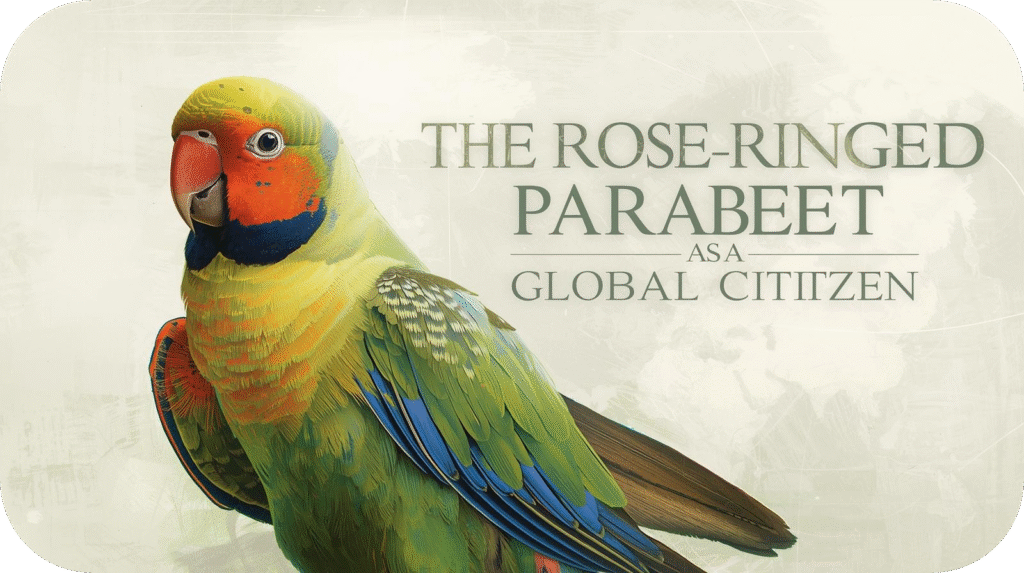
Native Range and Introduction to the World
The rose-ringed parakeet lifespan has a disjunct native range, with populations in sub-Saharan Africa and the Indian subcontinent . There are four subspecies, with the Asian subspecies ( P. k. manillensis and P. k. borealis) generally being larger than their African counterparts.
Their ability to adapt and their popularity in the pet trade have led to their spread to many other places. People now find feral populations in Europe, parts of the United States, South Africa, the Middle East, and Japan.
A Successful Invasive Species: Causes and Impacts
The rose-ringed parakeet is one of the most successful invasive species among parrots. Several factors contribute to this success:
- Dietary Flexibility: They readily adapt to eating agricultural crops, garden produce, and food from bird feeders.
- Climate Tolerance: They come from warm tropical areas. They can surprisingly survive cold winters. This ability helps them move into northern European cities.
- Nesting Adaptability: They are cavity nesters. They can easily nest in buildings and other man-made structures when tree hollows are not available.
However, this success creates ecological problems. In their introduced ranges, people often consider them an invasive species. These issues include:
- Agricultural Damage: Large flocks can cause significant economic losses in orchards and grain fields.
- Competition with Native Species: They compete strongly with native birds and other animals that nest in cavities. This includes bats and woodpeckers. In Europe, predators attack and kill greater noctule bats to take over their roosts.
- Potential Impact on Ecosystems: Their large, noisy flocks can disrupt the behavior of native species.
Managing the Rose-Ringed Parakeet Lifespan Population:
Addressing the challenges posed by feral parakeets population is complex and requires careful, science-based management. These issues are solve through a variety of strategies:
- Population Monitoring and Research: Scientists regularly count and study feral populations. They want to understand their size, distribution, and impact. A 2015 Europe-wide count, for example, documented over 85,220 parakeets .
- Public Education: It is important to inform people about the problems caused by releasing pets. We should also teach them not to feed feral animals. This is a key way to prevent issues.
- Non-Lethal Control: Some places work to make nesting sites harder to reach. They also use deterrents to stop roosting in problem areas.
- Culling and Nest Removal: In some regions where the impact on agriculture or native species is severe, controlled culling or removal of eggs and nests is employed as a last resort. For instance, Spanish authorities have drawn up plans to curb their ever-growing numbers .
These management strategies do not aim to get rid of rose ringed parakeet lifespan. Instead, we aim to control their population. This will help reduce their negative effects on local ecosystems and economies.
Practical Advanced Care and FAQs
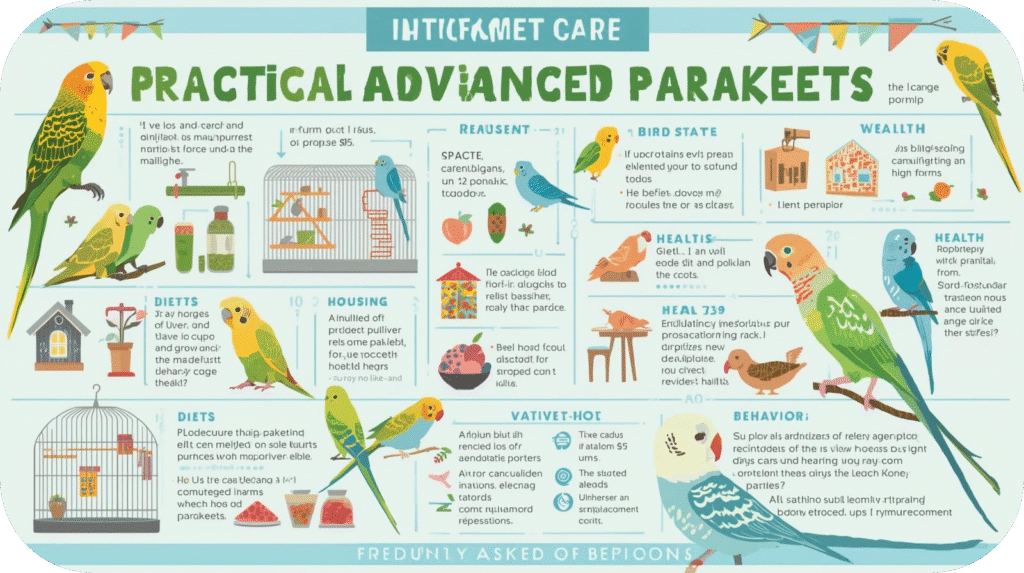
Providing Exceptional Care Through Enrichment
To give great care to a ring-necked parakeet, we need to go beyond basic needs. We should use special enrichment strategies that match their high intelligence.
- Foraging Opportunities: In the wild, they spend much of their day foraging. Use puzzle feeders and foraging toys that hide treats to stimulate this natural behavior and prevent boredom.
- Training and Social Interaction: These birds thrive on positive reinforcement training. Short, daily sessions to teach tricks or words provide mental stimulation and strengthen your bond.
- Change things up: Regularly switch toys and rearrange the cage safely. This keeps their environment fresh and fun.
FAQs about Rose-Ringed Parakeet Lifespan
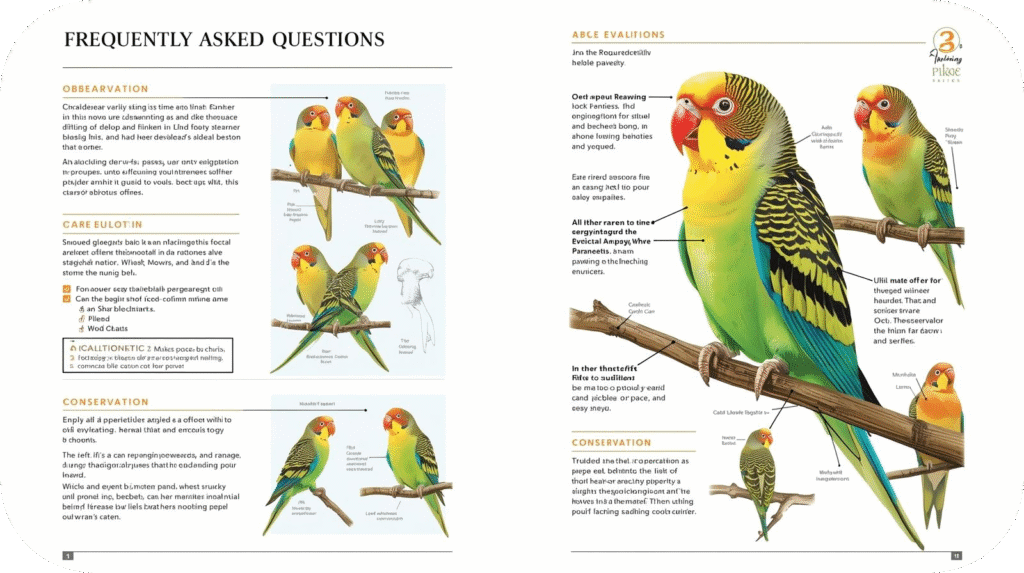
1. How long do rose-ringed parakeets lifespan live?
With proper care, these parrots typically live between 25 and 30 years in captivity, making their care a long-term commitment.
2. Can they talk?
Yes, rose-ringed parakeets are excellent talkers, particularly males. They can learn a large vocabulary and mimic sounds with remarkable clarity.
3. Are they good pets for beginners?
Their intelligence, strong personality, and long lifespan can be challenging for first-time bird owners. However, a dedicated beginner who thoroughly researches their needs can be successful.
4. What is the difference between a parakeet and a rose-ringed parakeet?
“Parakeet” is a broad term for many small to medium-sized parrots with long tail feathers. The rose-ringed parakeet is a type of parakeet. People know it for its size, green color, and the unique neck ring that males have.
5. Why is my parakeet plucking its feathers?
Feather plucking can have medical causes (infections, parasites) or behavioral causes (boredom, stress, loneliness). A visit to an avian veterinarian is essential to rule out health problems first.
Conclusion: A Living Link to History of Rose-Ringed Parakeet Lifespan

The rose-ringed parakeet lifespan is not just a pretty pet. It shows how evolution and adaptation work. This bird is a living piece of natural history.
Its flight feathers show complex engineering. It also has a deep evolutionary history that links it to dinosaurs. Owning one is a profound responsibility that requires a commitment to exceptional care for decades.
As we enjoy their beauty and intelligence at home, we must also see their role in the wild. They can be both beloved native birds and troublesome invasive species. By respecting this balance and giving dedicated care, we can help these amazing long-tailed parrots thrive for years to come.

Leave a Reply